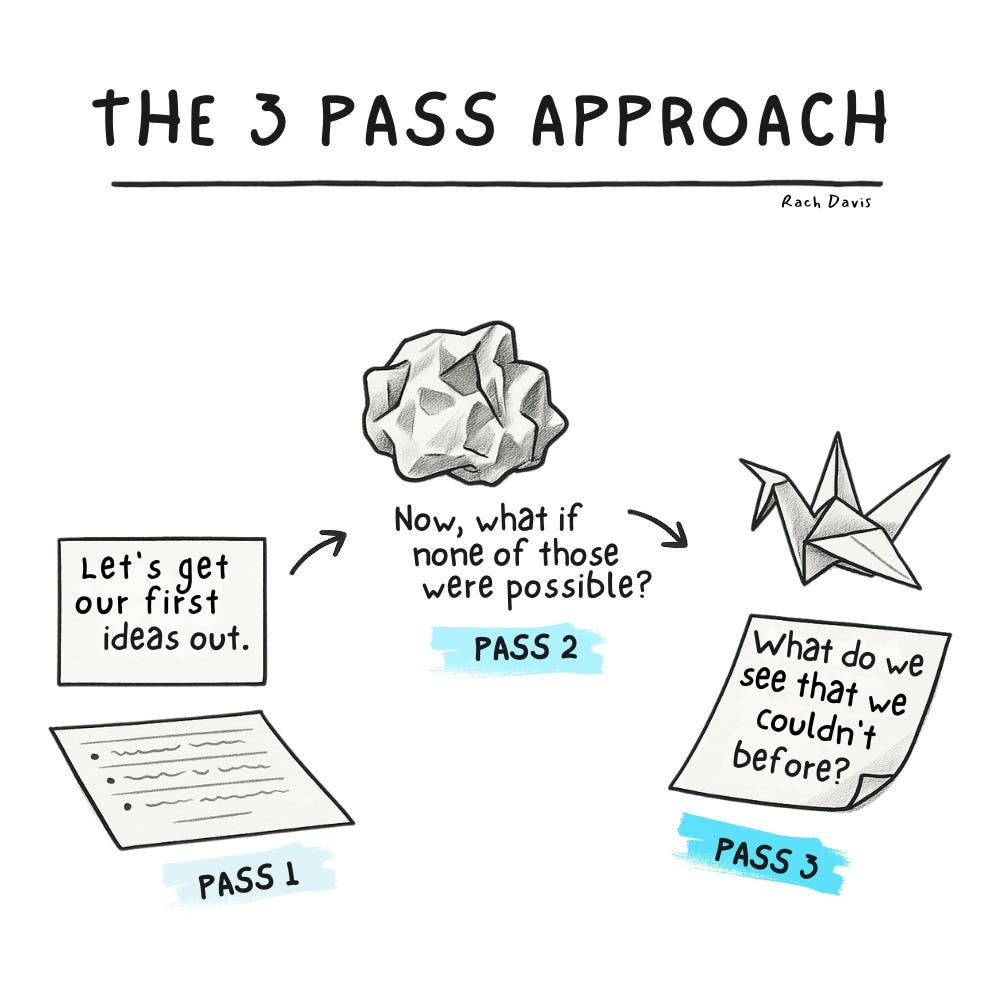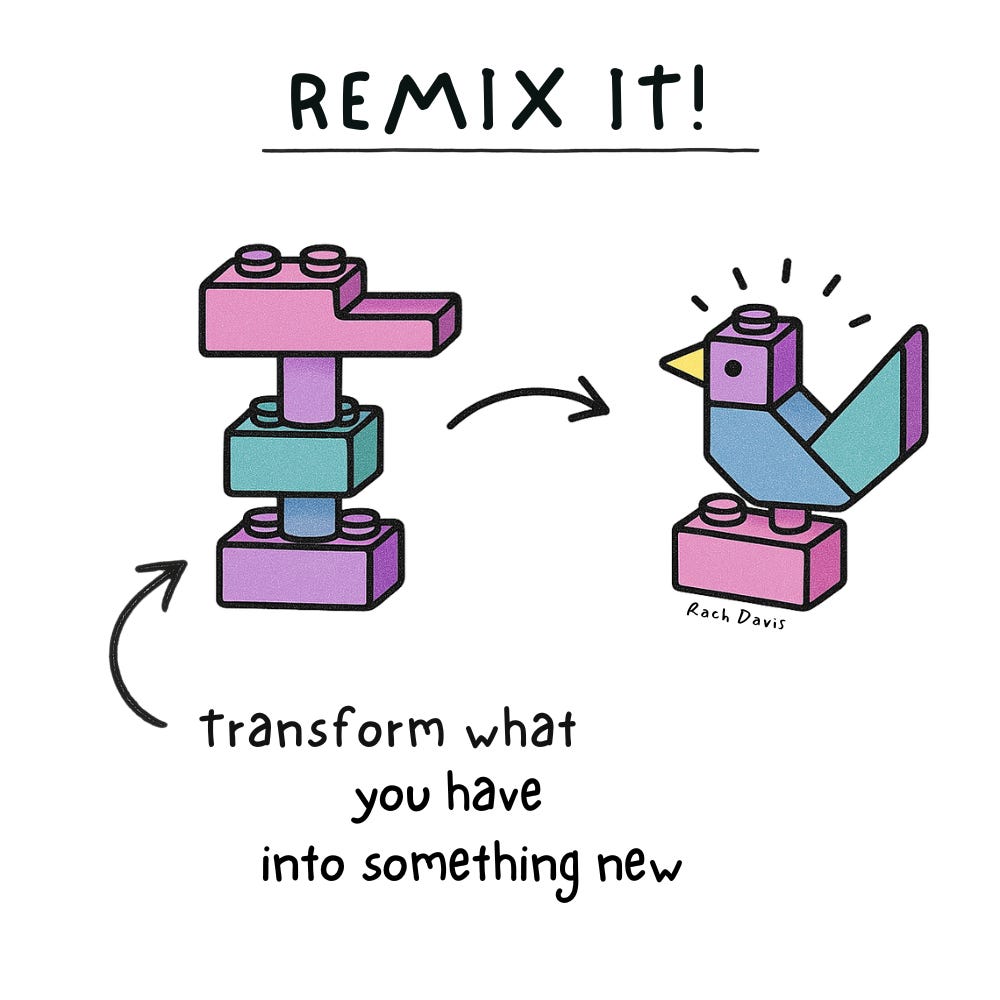The 3-Pass Approach — A Technique for Tackling the First Answer Trap
'Not So Fast' article series on how to challenge default answers
Let’s get started with our techniques for tackling the First Answer Trap. If you haven’t read the first article in the series yet, you can take a moment and peruse that one for a bit on why our brain defaults to familiar and easy thoughts.
People bring patterns into every conversation. They speak from what they’ve seen, what’s worked, what won’t get weird looks. And sure, that’s fine — for the first round.
But if you want anything beyond that, you need to interrupt the pattern. That’s when you get something more unique, maybe stranger, and probably more useful.
The 3-Pass Approach gives you a way to do that. It’s simple to run. And it gets you out of the default answer rut.
How to Facilitate the 3-Pass Approach
The setup is straightforward: three rounds of input, each with a different constraint. You’re not just trying to generate more ideas—you’re creating conditions that let different ideas and paths surface.
Let’s get to it!
Pass One: Get the initial ideas out of heads.
Start with a wide-open prompt. No curveballs. Ask the question, share the challenge, then ask, “What comes to mind?”
Let people respond quickly and without overthinking. Get those gut reactions. Let them fall into the first answer trap, don’t stop them.
Surface what’s already top-of-mind. The obvious, the safe, the patterned responses that people reach for out of habit.
Why let this happen? It gives us a snapshot of the group’s default thinking and something to push against in the next pass. Most sessions stop here — you won’t.
Pass Two: Now, what if none of those were possible?
This is the flip. This pass is about what happens after the easy is gone.
Take everything that just came up, and politely toss it out.
As a facilitator, you share with the group, “Let’s imagine none of those are on the table anymore; they aren’t possible. What else could we do?”
Introduce friction. People will pause, stall, and maybe push back a little. They will be uncomfortable. Good. That’s all part of it.
The point isn’t to frustrate — it’s to let people feel that the usual stuff isn’t going to cut it here. And then watch what comes up when they realize they need to go somewhere else. You’ve just cut off the obvious path, and now they have to take a different route.
These ideas most likely won’t feel polished, and that’s what we want. They are possibilities — they are new and different.
Pass Three: What do we see now?
Now, it’s time for some sense-making. We can look at what’s emerging and ask, “What do we see now that we didn’t before?”
This is the time to notice.
Notice what’s different.
Notice what feels worth exploring.
Notice what surprised you.
No evaluating quite yet here. You’re guiding observation and reflection. Pass three is not about consensus. It's about resonance.
So, Now What?
The last step is about figuring out what the group does now. Here are some possible paths for what happens after the 3-Pass Approach.
Evaluate.
Shift from noticing to choosing. Move the group towards clarity and commitment.
Tools you can use for evaluation:
The 2x2 Matrix
Helps you evaluate ideas, solutions or thoughts in two dimensions. The most common 2X2 matrix is impact versus effort, but you can label the variables in a way that aligns most with your topic or what you want to evaluate. Choose two things that matter—urgency vs. alignment, risk vs. value, clarity vs. controversy—and evaluate the ideas across those.
Dot Voting with Context
A quick visual way to get thoughts down about what’s bubbling to the top for people. Give context on what you’d like them to vote on.
Map.
If the group has surfaced a lot (which is the whole point!) but it’s scattered, raw, or just a little fuzzy then don’t force a decision. Instead, map it. You want to look for patterns and themes here. After that maybe then you can move to Evaluate.
Tools you can use for mapping:
Traditional Clustering
This is where you group similar ideas together. The similarities can come from topic, theme, or even language. Part of this is organizing duplicate or overlapping ideas.
Vibe Clustering
Clustering ideas based on the feeling behind them. Grouping ideas by what kind of energy they carry. As ideas start to get grouped, you can name the vibe category together — feels safe, quietly powerful, bold, playful, etc. You can set some vibe categories up front as a starting point or let them all emerge naturally.
Intent Mapping
Grouping ideas based on why they exist. This is a shift to “What’s this idea trying to do?” You might use this when you have many ideas and thoughts, but nothing feels particularly strong yet. Some categories that might come up after discussion (or you can start with) might be ideas that delay decisions, seek clarity, reduce complexity, avoid conflict, lean into tension, push for speed, etc.
Remix.
When your ideas after the 3-Pass Approach don’t feel quite there yet, you might want to shape them in different ways to turn them into something new. You've already cleared out the obvious, but there may be gaps where you can go even further.
Tools you can use for remixing:
Mashups
Taking two (or more) ideas and smushing them to work together, even if they weren’t meant to. Mashups give the group a way to shape something new without starting over after a 3-Pass Approach. You can take where you've gotten to and do more with it, get more creative, and use the friction of colliding perspectives.
Idea Transformations
This is based on SCAMPER, but let's be honest, who the heck knows what SCAMPER is? Instead, pick a word that resonates, and make each letter represent a transformational word that shifts, changes, or stretches ideas. Check out this reference for a transformation word for each letter of the alphabet.
And there you have it! Now you have a technique and follow-up methods to help you go past the default, past the mediocre! I’d love to hear how this works for you in the comments. Stay tuned for the next technique in the series, Reframe Roulette!
✨ Here’s to breaking routine, welcoming the weird, + workshopping with wonder. ✨






Love this...every morsel of it!